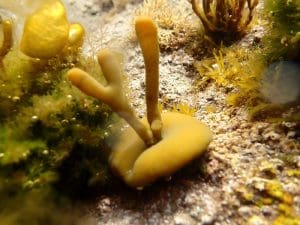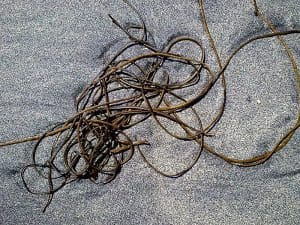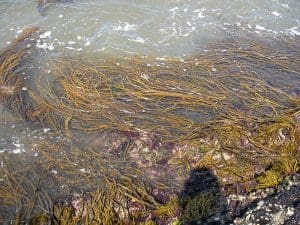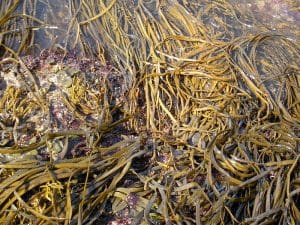Sea Spaghetti / Spring / Summer / Autumn / Edible
Other Common Names:
Thongweed
Latin Name:
Himanthalia elongata
Harvest Season and Notes:
From April-October the long strands will be growing – harvest them before they have developed too many spots which is the site of gamete (reproductive cells) release.
Habitat:
Thongweed grows on hard substrates like rock and is to be often to be found between the wracks and kelps. It likes strong tidal exposure but is less likely to be found at exposed sites later in the year. If found growing on a rock, only harvest one of the two strands (never pull the button right off as the seaweed won’t be able to continue reproducing), otherwise, take what looks clean and fresh from what has washed up in the rockpools.
Range and Distributions:
Found all around the western coasts of the UK and Ireland, as well as the eastern side of northern England. It can also be found on the western and northern coasts of France, Spain and Belgium.
Conservation Considerations:
Thongweed is relatively robust, but cannot stand changes to water salinity and increases in suspended water sediment.
Physical Characteristics:
Sea spaghetti grows from a small brown button, producing two long, dark brown strands from April to October. The strands are long, flat and solid, and later in the year, they gain spots. They can be over a metre long.




Could be Confused with, and Other Safety Notes:
There are other seaweeds with long strands such as mermaid’s tresses/bootlace weed, but thong weed is notable by its flattened, solid structure whereas the former is a hollow tube. As with all seaweeds, a very high iodine content means that those with thyroid issues or taking thyroid medication should take great care if increasing their seaweed intake, letting their healthcare provider know.
Edible Uses:
Thongweed is a sea vegetable of very diverse uses. It may be used, as its namesake suggests, as pasta after blanching in boiling water for 1-10 minutes (see how well done you like it), or included in pickles, fresh salads, chutneys, pies and sauces. As with other seaweeds, it may be powdered and used to thicken soups and stews. Forager Monica Wilde marinades her sea spaghetti in lemon juice or sea buckthorn juice for 10-20 minutes prior to cooking (see the link to her blog below).
Medicinal Uses:
As with all seaweeds, sea spaghetti is very high in minerals and salts due to needing to retain enough water in a very saline environment. This makes it a wonderful tonic food, important in the maintenance of a thriving nervous, immune and just about every other body system. Consume in moderation – see the safety section above. Clinically (by medical herbalists), seaweeds are often used for skin and skeletal issues.
Extra Points, Tips and Fun Facts:
Thongweed, along with many other seaweeds, has been used commercially in agriculture as a source of fertilising nutrients.






Leave a Reply
You must be logged in to post a comment.